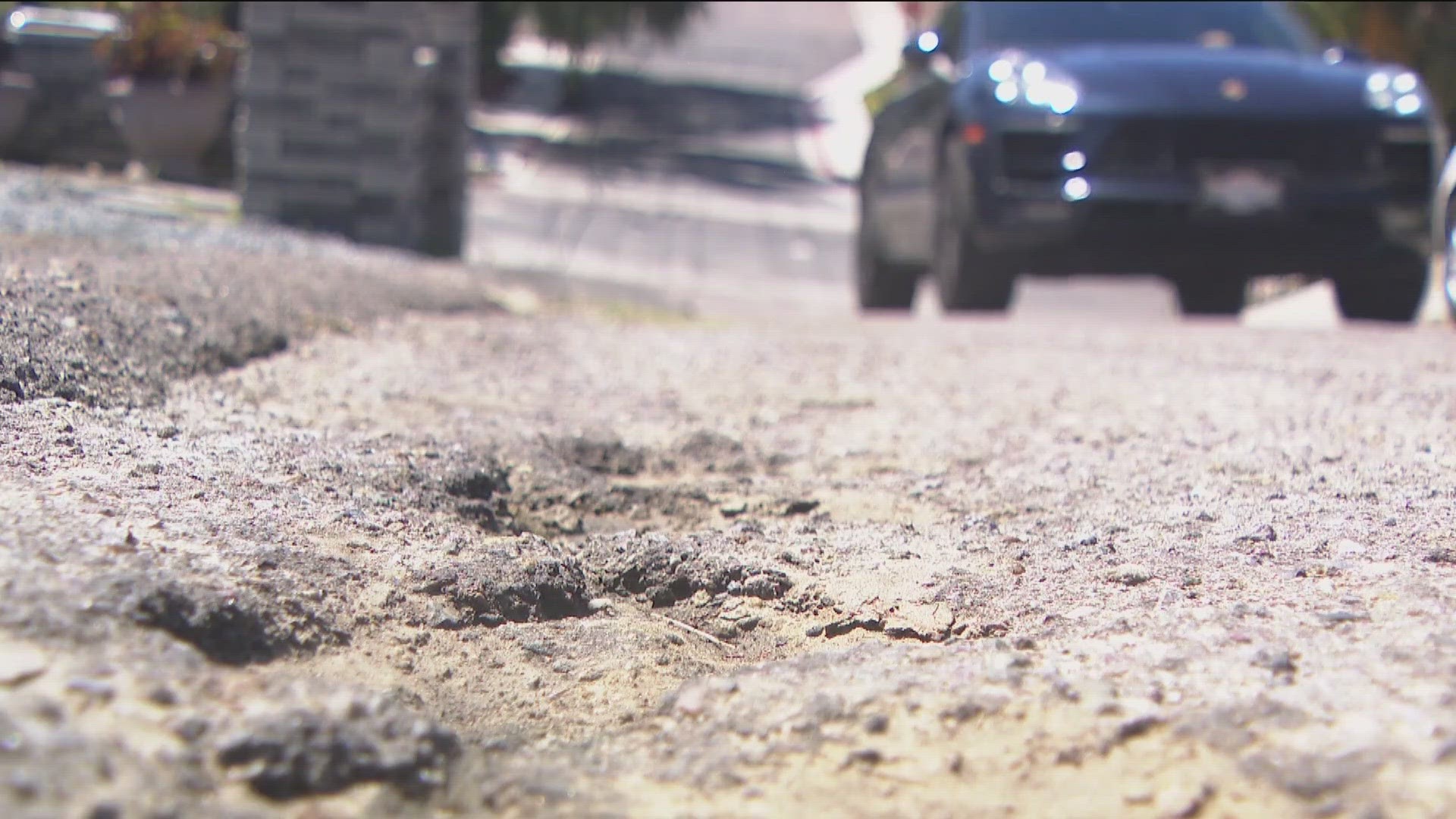SAN DIEGO — San Diego's roads are failing. According to a 2024 street assessment, the city received a score of 63 out of 100.
But which communities in San Diego have the worst roads?
According to the city's pavement condition index, city road teams designated 594 street segments as "failing" or by the city's definition streets that are "extremely distressed and require full reconstruction."
San Diego deems any road that has a score of 10 or under as 'failed.'
The highest concentration of failing roads is located in the neighborhoods in Southeast San Diego.
- City data shows 108 roads in and around South San Diego scored under 10. This includes the Community Planning areas of Skyline-Paradise Hills (55), Encanto (43) and Southeastern San Diego (10)
- The community with the second-highest number of failing roads is Clairemont with 92 listed as failing
- Followed by Mira Mesa (81)
- San Carlos and Del Cerro (41)
- Neighborhoods in and around Mission Beach and Mission Bay (24)
Search for failing roads in your community:
Of the 594 failing roads, only 79 have the funding needed for repairs over the course of the next five years.
Councilmember Kent Lee represents communities of Mira Mesa and parts of Kearny Mesa which have among the most failed roads in the city.
Lee admits that the city's roads are failing but says progress is being made.
"We all recognize that our streets are the butt of a joke and that many are not in the condition that we would expect or want," said Lee. "One of the challenges that we face as a city is recognizing that this is not a new problem. It is honestly a problem that has resulted from decades of disinvestment in our streets. It's not a single administration or even a single council member."
Lee says that while residents are often reminded about San Diego's shoddy roads during their daily commute, they often don't see the real progress that is happening at that moment.
One example, said Lee, is Gold Coast Drive, where the city is nearing completion of a $13 million improvement to the stretch of street.
Lee said that he also hears concerns from residents that the city is busy pouring money into largely unused bike lanes when it could be fixing city streets.
The council member said that the two go hand-in-hand.
"They're not exclusive of each other," said Lee. "The reality is bike lanes typically happen because the streets get done. And, funding that we receive often for broad infrastructure projects, for streets, that might include bike lanes, doesn't just cover bike lanes, it helps to fund sidewalks, storm drains, and culverts that are integral to the street working. It also funds repaving streets or restructuring streets in a way that makes sense moving forward."
In a statement, a city spokesperson said that the city needs $1.9 billion just to get the city's overall street grade to an average of 70.
Reads the city's full statement:
The majority of the streets included in the 5-year plan (Fiscal Years 2025 through 2029) are unfunded. The City estimates the 10 year funding need to achieve an average network Pavement Condition Index of 70 is $1.9 billion, and the estimated funding gap is $1.2 billion. Additional funding is needed to improve failed streets throughout the City of San Diego, since these streets need to most costly treatment method. The City uses a variety of treatments based on the condition of the road (see attached road repair graphic). These treatments range from maintenance treatments like slurry seal, which costs approximately $220,000 per mile, to asphalt overlay, which costs approximately $1.7M per mile, to reconstruction, which ranges from $6M - $9M per mile. Failed streets require the most costly treatment method, which is reconstruction.
The 5-year plan will be updated annually based on the amount of funding received each fiscal year. If additional funding is received it can be allocated to failed streets.
As part of the Pavement Management Plan, the City evaluated three street selection approaches (worst first, most people impacted, and best value) to determine the level of funding needed to achieve an average network PCI of 70 in the next 5-10 years. The selected approach was the 10 year best value approach, which prioritizes treating streets before they fall into more costly treatment categories (e.g. before they fall into overlay or reconstruction treatments). The worst streets first and most people impacted approaches did not achieve the goal of an average network PCI of 70 even if $400M were to be allocated annually for 10 years, because the funding was being allocated to the streets with the most costly treatments, and was not enough to keep up with maintaining streets in good to poor condition. For reference, the average budget for the paving program since FY13 is $46M annually, and the average budget needed for the next 10 years under the best value approach is $188M annually.
WATCH RELATED: Report | San Diego needs long-term funding plan for city streets

